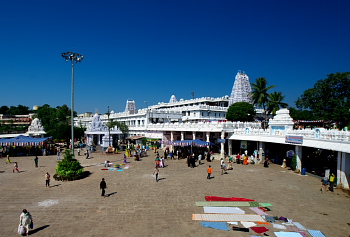 Annavaram temple of Lord Sri Veera Venkata Satyanarayana Swamy is located at a distance of 125 KM from vishakapatnam 80 KM from Rajamandri National Highway number 5 passes through Annavaram. The bypass road (NH - 5) goes straight and to visit the temple take right turn in the junction near the Annavaram. It takes two and half hours from vishakapatnam from Rajamandri side it will take 2 hours. Separate pooja halls are available for offering special pujas.
Annavaram temple of Lord Sri Veera Venkata Satyanarayana Swamy is located at a distance of 125 KM from vishakapatnam 80 KM from Rajamandri National Highway number 5 passes through Annavaram. The bypass road (NH - 5) goes straight and to visit the temple take right turn in the junction near the Annavaram. It takes two and half hours from vishakapatnam from Rajamandri side it will take 2 hours. Separate pooja halls are available for offering special pujas.Annavaram railway station is located at main Chennai – Howrah (Kolkatta ) railway line. Many trains stops here and from the railway station the temple is 3 KM. While going towards Chennai side this temple falls in right side and can be seen from the moving trains. Railway station and moving trains are visible from the temple also.
There are so many parking places for private vehicles on the hill surrounding the temple. Well equipped lodge facilities available. Free darshanam is with normal que and special darshanam with additional fees of either INR 25/- or INR 116/- are also available.
Prasadam counter is available on the national highway for those who are not able to visit the temple.
This temple is located at a hill top. Vehicles are allowed to climb up the hill. At the top of the hill guest houses for staying are available. Many mirages are preformed here so during this seasons you may have to book in advance if you a plan to stay here. There is a facility of quick Darshan in busy seasons. The main status is covered in two floors. The ground floor is for Pada darshan or to view the feet of the god. The first floor is the upper part of the Lord Venkata Satyanarayana Swamy.
From this hill top you can get a panoramic view of the surrounding green fields and villages. There is a river water barrage with boating facility and it can be visited while going up or while returning from the temple, available nearer to the main entrance of the hill. This place is called Pampa Sarovara. Boat ride gives a memorable experience to the visitors.
Inside the main temple complex photography is not allowed. However, around the temple there are so much of panoramic view available for viewing and enjoying the nature's beauty.
Temple history
As per the puranas the presiding deity of the place blesses the devotees with Anina Varam (Wanted Boon) the place is called Annavaram.
The hillock by the side of the village is considered to be very sacred. Meruvu the Lord of the hills and his consort Menaka did great penance and begot two sons by the grace of Lord Vishnu. One was named Bhadra and the other Ratnakara. Bhadra pleased Lord Vishnu with his devotion and penance and with his grace became Bhadrachalam on which Lord Sri Rama had permanently settled. Ratnakara desired to emulate his brother and succeeded in pleasing Lord Vishnu by his penance to settle on him as Veera Venkata Satyanarayana Swamy, Ratnakara remaining as Ratnagiri hill.
The temple of Sri Veera Venkata Satyanarayana Swamy is the main temple on the Ratnagiri hill. There is also a temple of Sri Rama and the shrines of Vanadurga and Kanaka Durga nearby. The temple of gramadevatha (village deity) is in the village at the foot of the hill.
It is said that Raja I.V.Ramanarayanam,the then zamindar of Gorsa and Kirlampudi estates, having been ordained by the Lord in his dream, traced the idol on the hill, worshipped it and installed it at the present spot on sravana suddha vidhiya of the telugu year Khara, 1891. The hillock it self is about 300ft above sea level, green fields all-round the hills and the pampa river encircling Ratnagiri. About 460 well laid stone steps leads to the top of it.
“The main temple constructed in the form of a chariot with the four wheels at each of the four corners. In front of the main temple is the kalyana mantapa, constructed and decorated with modern pieces of architecture. As we go down the way, we come across Ramalaya and then the shrines of Vana Durga and Kanaka Durga.
The Akriti of any temple is, according to the Agni Purana, merely a manifestation of the Prakriti. According to this the chariot of the temple is intended as a symbol of the Seven Lokas and the seven Lokhas above with, the garbhalaya of the Lord, at the heart’s center ruling over the entire Universe.
The temple at Annavaram has been constructed to depict this idea concretely. The front side of the temple depicts the chariot. The Meru on the floor with the pillar at the center, and the idols at the top are intended to bring forth the idea that the Lord not only remains at the heart’s center but also permeates the entire universe. The wheels depicting the Sun and the Moon serve to remind us that this Juggernaut moves on the wheels of time, and goes on for ever and ever, Thus the Annavaram temple satisfies both the ritualistic values and the spiritual aspirations of the devotees.”